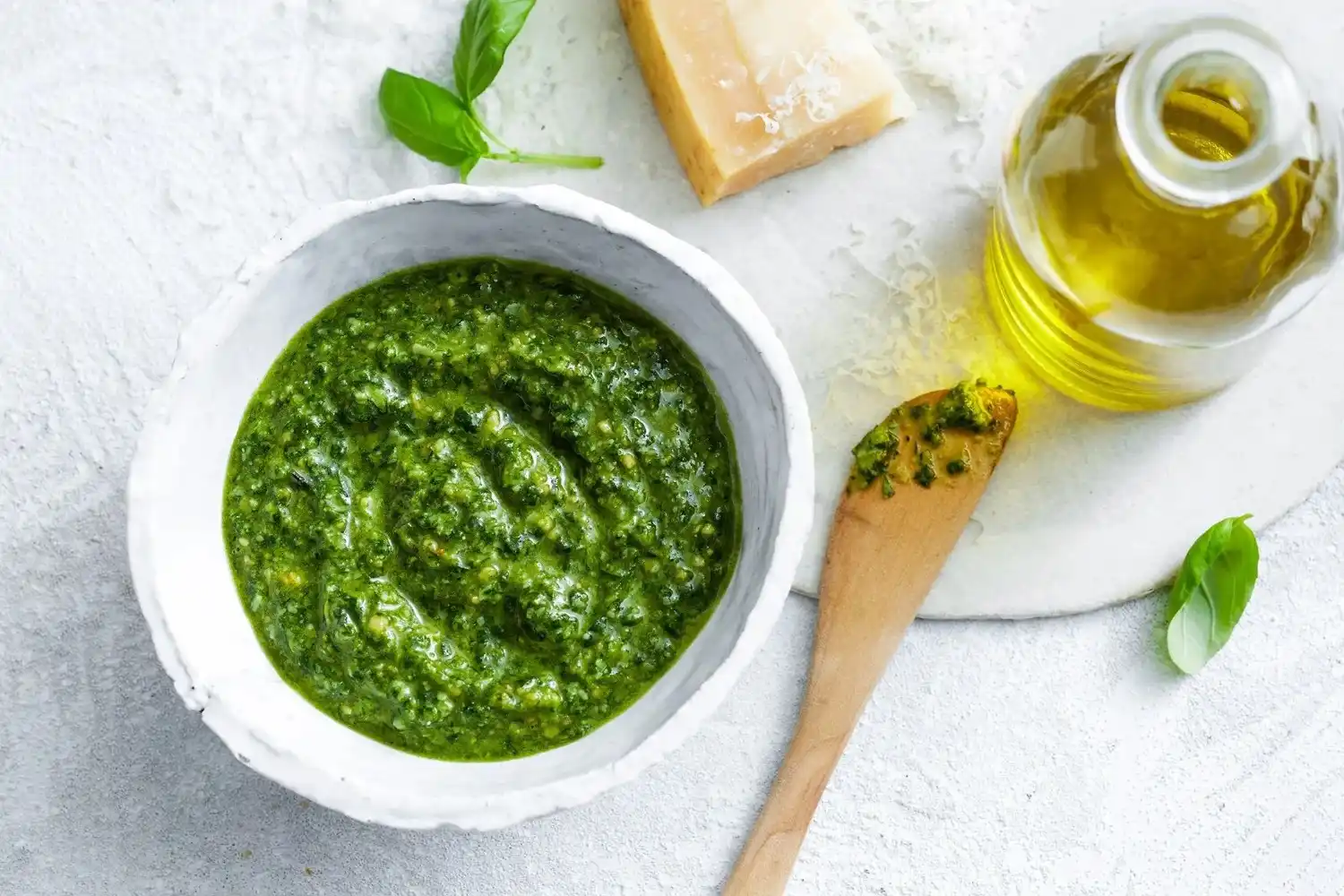Published on May 17, 2025
Last updated: May 17, 2025 · ⏱ 3 min read
Make Fresh Basil Pesto in Minutes

The Art of Making Homemade Basil Pesto
There's something undeniably special about a vibrant, homemade basil pesto. This sauce, bursting with flavor and freshness, can transform even the simplest of dishes into something extraordinary. Whether you're a seasoned chef or a cooking novice, mastering the art of pesto is both easy and rewarding. In under 10 minutes, you can create a delicious sauce that enhances your meals and satisfies your taste buds.
What Is Basil Pesto?
Basil pesto, originating from the Italian region of Liguria, is a classic sauce made primarily from fresh basil leaves, garlic, pine nuts, Parmesan cheese, and olive oil. The name “pesto” comes from the Italian word “pestare,” which means to crush or pound, referring to the traditional method of preparing the sauce using a mortar and pestle. Today, most people use a food processor to achieve the same delightful results in a fraction of the time.
Essential Ingredients for Basil Pesto
To make a classic basil pesto, you will need the following ingredients:
- Fresh Basil Leaves: The star of the show, fresh basil provides the signature flavor and aroma.
- Garlic: A couple of cloves add a punch of flavor that complements the basil perfectly.
- Pine Nuts: These nuts contribute a delightful creaminess and a subtle nutty flavor.
- Parmesan Cheese: Grated Parmesan adds richness and umami, enhancing the overall taste of the pesto.
- Olive Oil: A high-quality extra virgin olive oil ties all the ingredients together, creating a silky sauce.
- Salt and Pepper: To taste, these seasonings help balance the flavors.
Step-by-Step Guide to Making Basil Pesto
Making homemade basil pesto is incredibly simple. Here’s a step-by-step guide to help you create this flavorful sauce:
- Prepare Your Ingredients: Start by washing the basil leaves thoroughly. Pat them dry with a clean kitchen towel. Peel the garlic cloves and have your other ingredients ready to go.
- Toast the Pine Nuts: For an extra layer of flavor, consider lightly toasting the pine nuts in a dry skillet over medium heat until they are golden and fragrant. This usually takes about 3-5 minutes. Be sure to stir frequently to prevent burning.
- Combine Ingredients in a Food Processor: In your food processor, combine the fresh basil leaves, toasted pine nuts, garlic, and grated Parmesan cheese. Pulse a few times to break down the ingredients.
- Add Olive Oil: With the food processor running, slowly drizzle in the olive oil. This will help emulsify the mixture and create a smooth sauce. Stop occasionally to scrape down the sides of the bowl to ensure everything is well-blended.
- Season to Taste: Once the pesto reaches your desired consistency, taste it and season with salt and freshly cracked pepper. Blend again to incorporate the seasoning.
- Store or Serve: Your homemade basil pesto is now ready to be enjoyed! Use it immediately or store it in an airtight container in the refrigerator. To prevent browning, pour a thin layer of olive oil on top before sealing.
Customizing Your Pesto Recipe
One of the best aspects of making your own pesto is the ability to customize it to suit your taste preferences. Here are a few variations and additions to consider:
- Different Herbs: While traditional pesto uses basil, you can experiment with other herbs like parsley, cilantro, or arugula for a unique twist.
- Other Nuts: If you don’t have pine nuts on hand, walnuts, almonds, or cashews can be excellent substitutes that add their own distinct flavor.
- Cheese Alternatives: If you're looking for a dairy-free option, nutritional yeast can provide a cheesy flavor without the dairy.
- Spices and Zests: Consider adding a pinch of red pepper flakes for heat or lemon zest for a refreshing citrus note.
How to Use Basil Pesto in Your Cooking
Basil pesto is incredibly versatile, making it an excellent addition to a variety of dishes. Here are some creative ways to incorporate pesto into your meals:
- Pasta: Toss cooked pasta with pesto for a quick and delicious meal. Add grilled chicken, roasted vegetables, or cherry tomatoes for extra flavor and nutrition.
- Sandwiches and Wraps: Spread pesto on sandwiches or wraps for a burst of flavor. Pair it with fresh mozzarella, tomatoes, and arugula for a delightful combination.
- Pizza: Use pesto as a pizza sauce base instead of traditional tomato sauce. Top with your favorite ingredients and bake for a unique pizza experience.
- Grilled Fish or Chicken: Marinate fish or chicken in pesto before grilling or roasting for a flavorful main dish.
- Vegetable Dips: Serve pesto as a dip alongside fresh vegetables or use it to enhance a cheese platter.
Storing Your Basil Pesto
If you find yourself with leftover basil pesto, proper storage is key to preserving its fresh flavor and vibrant color. For short-term use, transfer the pesto to an airtight container and store it in the refrigerator for up to one week. To prevent oxidation, you can pour a thin layer of olive oil on top of the pesto before sealing the container—this helps maintain its bright green appearance.
For longer storage, consider freezing your pesto. Spoon it into an ice cube tray for easy portioning, and once frozen, transfer the cubes to a freezer-safe bag or container. Frozen pesto can last up to three months and is perfect for quick meals—just drop a cube into hot pasta, soup, or sauces. Whether chilled or frozen, storing your basil pesto the right way ensures you can enjoy its delicious taste anytime.
FAQs: Homemade Basil Pesto

Written by Soufyan from GrowToGrub
Soufyan is a gardening educator and founder of GrowToGrub. Through simple guides, easy recipes, and practical life hacks, he helps everyday growers turn small spaces into sustainable, delicious, and chemical-free living.


